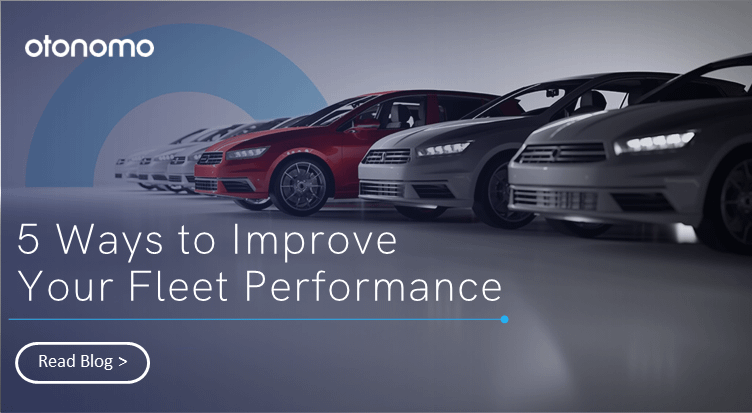Otonomo recently hosted a webinar titled “5 Ways to Improve Fleet Performance”. Our guest, Albert Schwitter, Chief Operating Officer at AXA Mobility Services AG, was joined by our very own Matt Krukin, Senior Vice President of Sales at Otonomo. Albert’s experience spans everything from being a car mechanic to managing fleets, and recently, managing a car subscription service that utilizes software-based telematics from OEM data. We discussed five ways to improve fleet performance that can all be implemented today. Below is a summary of the discussion we had during the webinar, and you can watch the recorded webinar here.
Automate The Use of Fleet Management Software
Automating the flow of data and information from vehicles to fleet managers via OEM data allows fleet managers to focus on what’s important. To automate this flow, you need to have the data points from your fleets accessible, such as vehicle maintenance records, odometer, which vehicles require more fuel and oil due to colder weather conditions, tire pressure, or battery status for EVs.
Aside from preventing human error, which is great, it also helps managers glean insights into vehicle health, analyze trips, look at maintenance, and see how to evolve the fleet they manage. Having automated data also helps in fraud prevention, with everything from locating vehicles in near real-time to establishing current and ongoing odometer readings to counter attempted odometer rollback fraud.
Once you have access to fleet data, you then need to include it in your workflows. This used to be a challenge, but fleet data is now available and easily accessible if you are using OEM-connected vehicles. In fact, you can onboard and de-fleet vehicles with a single click.
Make Data-Driven Decisions
As Albert Schwitter from AXA Mobility Services AG put it: “We like being hands-on with the data we have, so we can engage actively with the customer, the driver and the car.” Even more importantly, with the data that you have available at your fingertips, you can create more touchpoints with your drivers and keep tabs on your vehicles, so that you don’t just meet them during scheduled maintenance and breakdowns.
With Otonomo’s software, you can make sense of complex variables like energy consumption and engine diagnostics, allowing fleet managers to access valuable vehicle information at-a-glance and make actionable decisions.
Practice Preventive Maintenance
It is common knowledge that vehicles that are well maintained burn less fuel, use less oil, and perform better overall. With connected vehicle data providing a high level of visibility into the fleet, fleet managers can adopt a proactive approach to maintenance.
Key vehicle metrics like low tire pressure, low EV charge, or high oil use are automatically sent to Otonomo’s platform and summarized in the maintenance dashboard, and can trigger alerts so that the fleet owner or manager can maintain control over issues as they occur. To stick with the tire pressure example, low pressure means you waste a lot more fuel, need more steering, and use more braking power to stop a vehicle. It all adds up, taking away from the bottom line. By staying on top of even just these minor repairs/fixes, you can reduce inefficiencies and vehicle wear down and keep the effectiveness of the fleet high.
Fleet managers can also look at their fleet in order to make decisions and prevent issues further down the road. For example, cars used mostly in mountainous areas have a higher consumption of fuel and oil, so the typical 20,000 km/2 years maintenance schedule (on average) may not be optimal for them, and they may need more frequent maintenance.
Encourage Good Driving Behavior
Better driving means safer drivers and less wear and tear on vehicles. It is a very important piece of the puzzle, and though it may seem subjective, now that we have access to vehicle data, it is easy to track and measure. In the past, punitive measures were used against drivers for negative reinforcement, but that created a lot of friction and backlash. However, in recent years there has been a shift towards driver safety that has turned towards positive reinforcement which can be powered by vehicle data.
Albert at AXA Mobility Services AG encourages good driving through competition. Or, as he puts it, “it starts with a barbecue”. At the barbecue, which is a yearly event, he sets up a competition for the best drivers. This has generated some staggering behavioral changes in the way people drive, including a 10% reduction in fuel consumption, and lower breakage and maintenance events.
There were some prizes offered, and since the competition proved to be such a huge success, additional prizes were added as a reward for the second and third places. But the real success was the spirit of competition it created between the drivers and their commitment towards safer driving.
When setting up a positive rewards program, it’s important to be transparent with the drivers, show them what kind of data you have, and assure them that their data is well protected.
Build a More Sustainable Fleet: Add Electric Vehicles (EV)
Sustainability is a big topic today. The shift from internal combustion engines (ICE) to electric vehicles (EV) should be powered by data in order to make the right decisions at the right time, so that the transition runs smoothly. Other considerations before bringing EVs into a fleet include where and how the vehicles will be charged, adding EV servicing to your current workflow, and the best types of EVs for your business and customers.
EVs may not be the right fit for all businesses, but the demand for alternatively powered vehicles is growing. Some organizations are looking to move from hardware-based to software-based telematic solutions, which enable them to avoid the hassle of aftermarket hardware, as well as removing their vehicles from installation or device management services. Companies of all sizes can now begin to evaluate their needs to determine how an EV transition policy can support their long-term goals and ensure they are meeting customer needs.
These are just some highlights from the discussion between our guest Albert Schwitter and Matt Krukin, VP of Sales at Otonomo. If you are more of a video person or want to enjoy the full conversation, you can watch the recorded webinar here.









